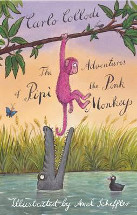The adventures of Pipi the pink monkey by Carlo Collodi

Retold and expanded by Alessandro Gallenzi and ill. by Axel
Scheffler. Alma Books, Bloomsbury, 2016. ISBN 9781847495594
(Age: 8+) Highly recommended. What's that I hear you ask? Carlo
Collodi? You mean the Italian guy who wrote Pinocchio? Yep, that's
the one I mean. And no, I didn't know he wrote anything else either!
By the way, if you have never read the original story but
are only familiar with the contemporarised versions (like Disney)
you should!
For the first time ever Collodi's 'other' story for children has
been translated into English and has also been tweaked by Alessandro
Gallenzi. Alessandro is the co-founder of Alma Books (Alma
being the Spanish for 'soul'). This independent publishing company
produces around seventy titles a year, many of them translations of
classics in languages other than English.
Aside from the fascination of all of this (and I do mean
fascination) the story of Pipi is quite charming. With definite
overtones of the world's most famous marionette, Pipi is very
different to his brothers not only in his silky pink fur but also
because he is the naughty one.
From stealing a peasant's pipe to losing his tail while tormenting
an old blind crocodile to meeting a little boy named Alfred and then
being captured by an infamous brigand, Pipi adventure's are
thrilling.
And just as the Fairy with the Turquoise Hair (you know D's Blue
Fairy) promised Pinocchio that he could become a real boy, the
rabbit with the turquoise fur makes good on the promise that Pipi
will regain his beautiful tail, if only he keeps his word.
I truly love that I can hear Collodi's turn of phrase and expression
in this translation. The story is followed by a wealth of extra
material for readers with a glossary of monkey language,
biographical information about the author including a letter to his
child readers, details of the characters and even other 'literary'
apes/monkeys.
All in all this is a delightfully different addition to any primary
library collection. Not least of all because the message it provides
to young readers holds just as true today as it did in 19th century
Italy.
Highly recommended for readers from around 8 years upwards.
Sue Warren